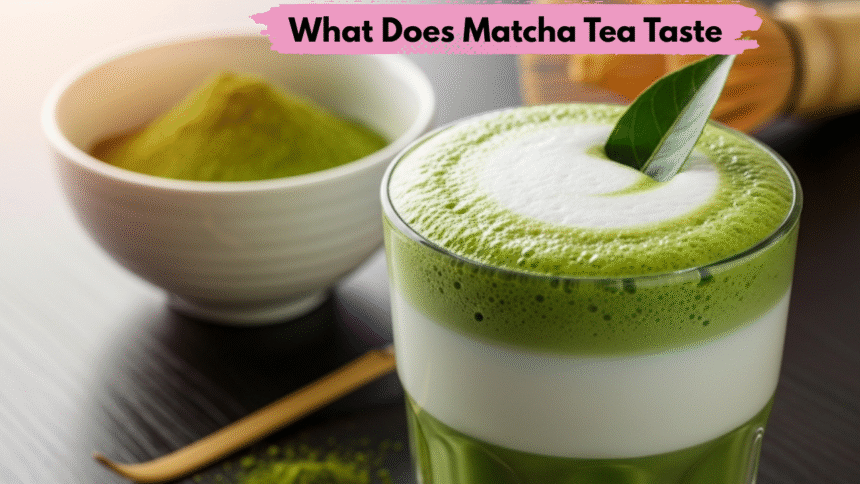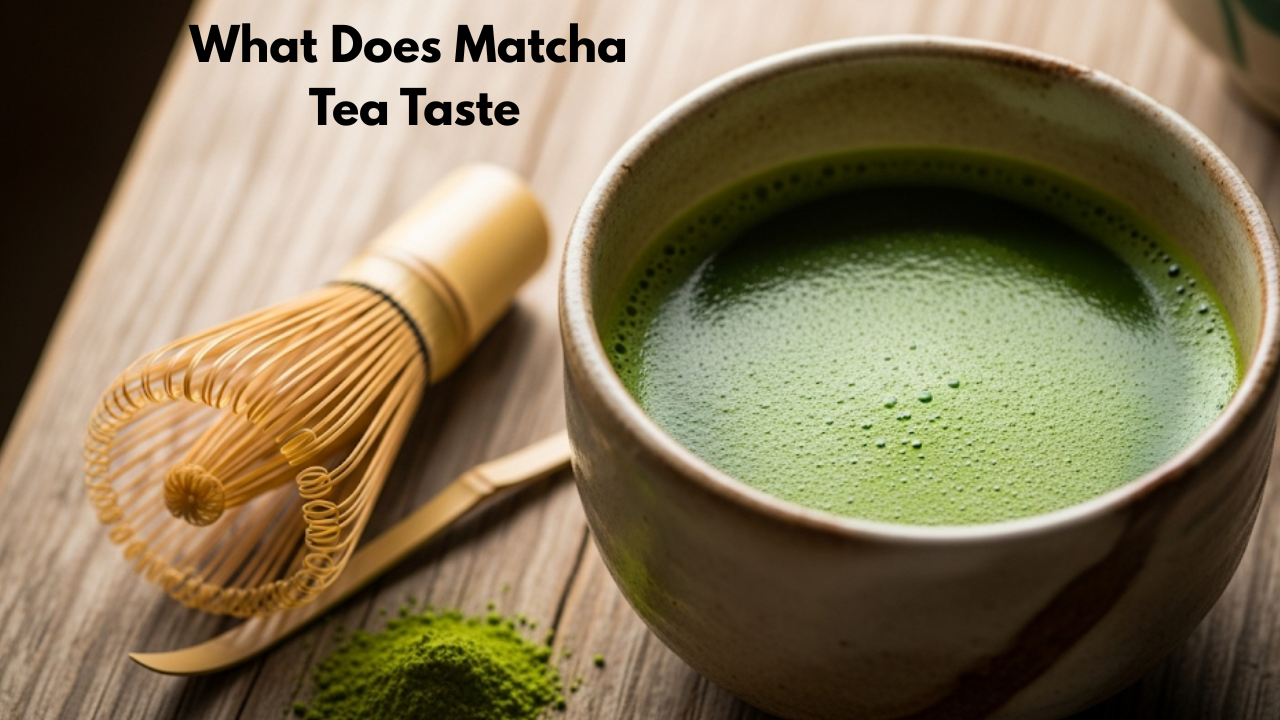You’ve probably seen matcha all over social media—vibrant green lattes, frothy bowls of tea, and even matcha-flavored desserts. But here’s the question every beginner asks: What Does Matcha Tea Taste like? If you’re about to try it for the first time, you might be wondering whether it’s sweet, bitter, grassy, or something else entirely.
The truth? What Does Matcha Tea Taste the others. It is rich, in layers and can be a little surprising during the first sip. But don’t worry – I will expect you exactly by that so that you do not feel blindly when this light green cup hit your taste buds.
A short intro: What exactly is matcha?
Before you immerse yourself with the taste, clearly leave us What Does Matcha Tea Taste. Matcha is a finely ground powder of specially cultivated green tea leaves. Unlike normal green tea, where they pull through the leaves and throw them away, they can drink the whole leaf. This is why its taste is stronger, more courageous and more complex.
The tea plants are shaded for a few weeks before the harvest, which strengthens chlorophyll and amino acids. The result? An animated green powder with a much deeper taste profile than your everyday tea bag.
First sip: the initial taste of matcha
How does your very first sip? Imagine the fresh and green taste of spinach or kale, but smoother and less lively. Add a soft bitterness (like dark chocolate), a hint of natural sweetness and a copious finish that persists.
It’s earthy. It is vegetable. It is a little sweet and even creamy if it is brought well. In other words, the match is like drinking the essence of green itself.
The role of human: the characteristic taste of Matcha
One of the main reasons What Does Matcha Tea Taste is distinguished is the UMAMI with a salty taste and that fill the mouth that you could associate with mushrooms, soy or algae sauce. Thanks to the shadow process, the leaves develop higher levels of l-teanine, which give matches its flexible and salty fist. Imagine Umami as the “fifth taste” that makes flavors more satisfactory. Without that, the matcha would just have taste the grass. This gives you a rich and full -body drink that looks like an earth and almost soothing.
Sweet in matcha: a hidden surprise
Here, it becomes interesting, high quality What Does Matcha Tea Taste has a subtle natural sweetness. Not like sugar, but rather like the sweetness that you notice in the steamed green or roasted chestnuts. It rounds bitterness and makes the general taste smoothly.
If you tried only bitter and hard match, there is a good chance that it was not of high quality. The real ceremonial grade match is in balance, stratified and surprisingly pleasant on the language.
Do all Matches have the same flavor?
Absolutely not. Like coffee or wine, the taste of What Does Matcha Tea Taste changes depending on quality and note:
Degree of ceremony -Matcha: Smooth, less bitter, of course sweet and full of Umami. It is traditionally appreciated by only hot water.
Culinary degree -Matcha: Stronger, bitter, slightly astringent. Ideal for slats, cooking and desserts, in which other flavors compensate for it.
So if your first sip is the culinary matcha, which has just been done with water, panic. It is intended for recipes that do not automatically sip.
Why do some people think that Matcha flavor “grass”?
We are honest – What Does Matcha Tea Taste is not a love with the first sip for everyone. Some people describe it as a tasting such as grass or algae. This usually happens when:
The match is of low quality. It is incorrectly prepared (too much dust, too hot or not well blocked water).
The palate is not simply used for bold and vegetable flavors.
Think like a black coffee – Most people don’t like the first time they try. But once you learn to appreciate the depth and complexity, it becomes compelling.
Match in different forms: how the taste changes
Here is the beautiful part: Matcha is not only for traditional tea bowls. It appears in slats, desserts, smoothies and even cocktails. And yes, the taste changes according to the way you appreciate it.
Matcha Latte: creamy, soft, with earthy notes that are raised by milk. An introduction for beginners.
Matcha ice cream or cake: slightly bitter, balancing the softness of sugar or cream. Matcha -Tee (Usucha): Light, sparkling, grassy and refreshing.
Dicker What Does Matcha Tea Taste (Koicha): Intensive, symbol and definitively full -tone an acquired taste.
So if you are nervous to go directly to traditional tea, start with a transverse bar or a dessert. It’s like immersing your toes before diving backwards.
The texture factor: more than taste
Besides the taste, matcha has a unique texture. Because it’s a powder tea, you don’t fall back: correct it in water. The result is a creamy and foamy drink with a light mouth light. This thickness makes it more filling and satisfactory than normal tea.
Some describe it as almost a milk, even without milk, which adds another layer to the overall experience.
High quality match spotting before tasting
Do you want to avoid an aspra disappointment? Learn to recognize the good match before even to narrow it:
Color: light green and lively means freshness. Boring or brown yellow? Low quality.
Texture: silky, good and smooth – it should look like a child powder.
Perfume: fresh, grassy, with a touch of sweetness – not similar to fish or old. Believe me as soon as you try a high quality ceremonial matcha, you would never want to go back to limestone and bitter stuff.
Develop a taste for matcha
Matcha is a taste acquired for many, and it is completely normal. The more you drink it, the more you start to notice its sweet and rich nuances in Umami instead of bitterness.
This is similar to what people learn to taste dark chocolate, red wine or black coffee. At first, it may seem overwhelming, but give it a little time and you will start to appreciate its depth.
Matcha combination with food
Matcha mating with the right meal can completely change your perception. Try these combos:
Sweet associations: white chocolate, mochi, cookies or pancakes.
Hearty couples: sushi, rice cracker or roasted nuts.
Fruity peers: strawberries, mango or citrus fruits illuminate its earthy tones.
Matcha’s combination is like playing with contrast – it can either improve cute or in -depth copious notes, making it one of the most versatile teas outside.
Matcha vs green tea: what is the difference in taste?
You can assume that What Does Matcha Tea Taste has a normal green tea taste – but not. Green tea has a lighter and tender taste, almost aqueous compared to matcha.
Matcha, on the other hand, is concentrated, creamy and fatty. If green tea is like sipping a light broth, the match is like enjoying a dense and tasteful stew. Both are good, but they are totally different experiences.
So how does Matcha tea really really?
Here is the bottom line: the match has a terrors, vegetable flavor, a little bitter, naturally sweet and full of humans. It is complex, stratified and different from other tea you will try. For beginners, it can be a little strange, even crushing. But as soon as you get used to it (especially with high quality matcha), you will appreciate the unique taste and creamy texture.
Read More: What Does Matcha Really Taste Like? A Beginner’s Guide
Conclusion
What Does Matcha Tea Taste is not only a tradition in green fashion – a secular tradition with a taste profile which is courageous, complex and deeply satisfactory. Of course, it has a taste for grass or bitter when you start with lower powder or poor preparation, but with the right approach, it is smooth, slightly sweet and filled with Umami.
If you are new in Matcha, start with a transverse bar or a dessert and work on the traditional tea path. Over time you will discover the magic behind that bright green cup – and perhaps even in love.






